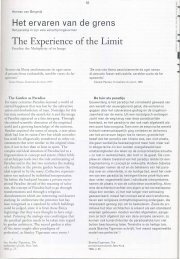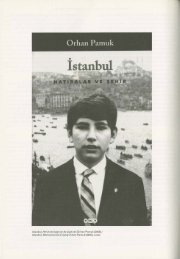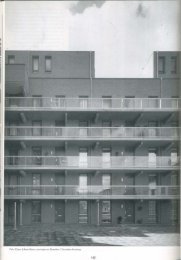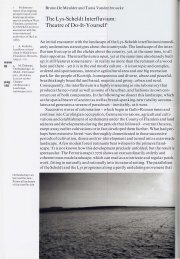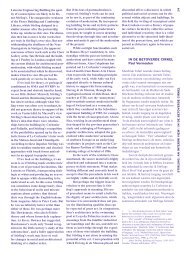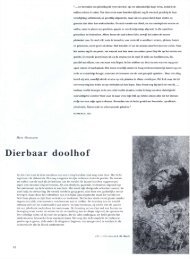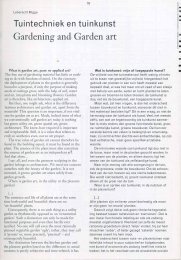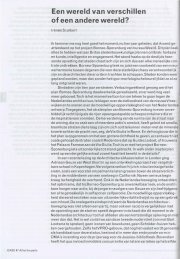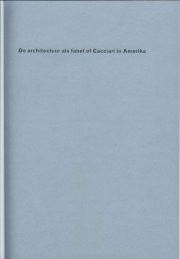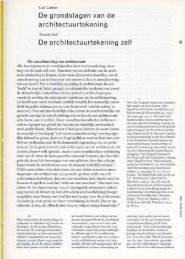Download PDF, 20 pages, 7.98 MB - Oase
Download PDF, 20 pages, 7.98 MB - Oase
Download PDF, 20 pages, 7.98 MB - Oase
Create successful ePaper yourself
Turn your PDF publications into a flip-book with our unique Google optimized e-Paper software.
1950s, which was also informed by readings of Le<br />
Corbusier. Banham remembers that all the younger<br />
architects 'came very directly under the influence of<br />
the brilliant revival of Palladian studies in England in<br />
the late Forties, either through Rudolf Wittkower, or<br />
through the teaching of his outstanding pupil Colin<br />
Rowe'.7 Despite the explicitness of the statement<br />
Banham does not offer much insight as to how the<br />
supposed influence materialised in the architectural<br />
work; the reader is invited to read the symmetry and<br />
geometric clarity of Hunstanton for evidence. He<br />
maintains that it was through a study of classicising<br />
tendencies in the work of modern masters - Mies and<br />
Le Corbusier in particular - that these sensibilities<br />
found their way into the designs of architects like<br />
John Voelcker and the Smithsons.<br />
The question remains as to how the influence of<br />
Architectural Principles can be defined if it is less<br />
direct than the initial outspoken adhesion on the part<br />
of the Smithsons might suggest. In a scholarly article<br />
that investigates the influence of Wittkower's book on<br />
Rudolf Wittkower, Architectural<br />
Principles in the Age of Humanism,<br />
London, 1949, p. 15.<br />
5<br />
Ibid., p. 18.<br />
6<br />
RIBA Journal, 59, 1952, p. 140.<br />
an isometric view of the facina fn.mes as welded<br />
toaether for boltint to the structural work.<br />
de jaren veertig, ofwel door Rudolf Wittkower, ofwel door<br />
de lessen van zijn uitzonderlijk begaafde leerling Colin<br />
Rowe'.7 Ondanks de duidelijkheid van deze uitspraak<br />
geeft Banham niet veel inzicht in de manier waarop de<br />
veronderstelde invloed tot uiting komt in het architectoni<br />
sche werk; de lezer wordt uitgenodigd de symmetrische en<br />
geometrische helderheid van Hunstanton te lezen ter<br />
bewijs. Hij houdt vol dat deze sensibilities hun weg vonden<br />
in de ontwerpen van architecten als John Voelcker en de<br />
Smithsons via bestudering van de classicerende tenden<br />
sen in het werk van moderne meesters als Mies en<br />
Le Corbusier.<br />
De vraag blijft echter hoe de invloed van Architectural<br />
Principles kan worden gedefinieerd als deze minder direct<br />
is dan de in het begin door de Smithsons uitgesproken<br />
waardering doet vermoeden. In een artikel waarin hij de<br />
invloed van Wittkowers boek op de ontwikkeling en de<br />
interpretatie van de moderne architectuur onderzoekt,<br />
onderscheidt de Amerikaanse kunsthistoricus Henry<br />
A. Millon drie ontwikkelingen in het Britse architectuur<br />
wereldje van de jaren vijftig.a Allereerst heeft het boek<br />
Reyner Banham, The New Brutalism, Ibidem, p. 18. 8<br />
London, 1966, p. 15. Banham 6<br />
published this text as an article in the RIBA Journal, 59, 1952, p. 140.<br />
Architectural Review of December 7<br />
1955. The book is a revised and Reyner Ban ham, The New Brutalism,<br />
enlarged version of the article. Londen, 1966, p. 15. Banham publiceer<br />
de deze tekst als artikel in de<br />
Architectural Review van december<br />
1955. Het boek is een herziene en<br />
lsonometrie van de gelaste gevelframes die door middel van bouten op de hoofdconstructie zijn bevestigd I<br />
lsonometric view of the facing frames as welded together for bolting to the structural work<br />
Detail verticaal schuifraam I Detail vertical sliding window<br />
77<br />
···'tz-'!:fk4 fy<br />
u--<br />
vertlcaltlldlna window and pt-etsed steel<br />
esbolc:edto fac:ina frame.<br />
uitgebreide versie van het artikel.<br />
Henry A. Millon, 'RudolfWittkower,<br />
Architectural Principles in the Age of<br />
Humanism: Its Influence on the<br />
Development and Interpretation of<br />
Modern Architecture', Journal of the<br />
Society of Architectural Historians<br />
(VS), 1972, p. 83-91.<br />
OASE # 49150 1998




